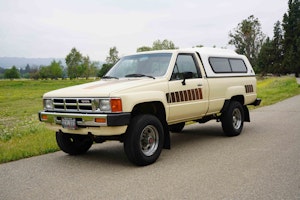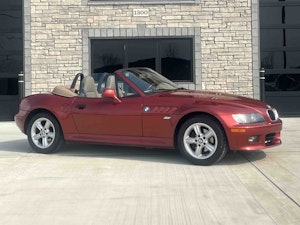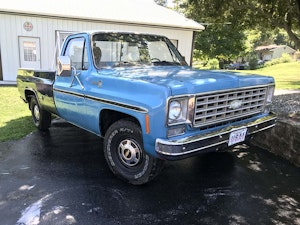Media | Articles
1975–85 Ferrari 308s are incredibly cool and increasingly affordable
If you were fortunate enough to be in the market for a brand-new Ferrari in 1975, you probably would have walked into the dealership, looked at what they had to offer, and walked out to go buy something else.
What you would have seen was the only car Ferrari officially brought to the U.S. that year—the Dino GT4. Powered by a new 2.9-liter V-8, the Dino GT4 wasn’t a bad car by any means, but being a 2+2 with Dino badges and Bertone styling, it was nowhere near as good as the 246 that came before. Simply put, it wasn’t everyone’s cup of tea.
The following year, however, Ferrari came back with the much more exciting two-seat 308, which would go on to become Ferrari’s high-volume sports car for a full decade. While a used 308 became one of the few affordable ways to get into vintage Ferrari ownership, that all changed a few years ago when most Ferraris, even the cheap ones, got pricey again. Though 308 prices have taken a step back in 2019, they are still highly collectible, refreshingly analog sports cars that look much pricier, and much quicker, than they really are.
Ferrari introduced the 308 GTB at the Paris Salon in October 1975 to be built alongside the Dino 308 GT4 and share its engine. The new two-seater would also wear Ferrari badges, only with no Dino script anywhere. Still, it was the true successor to the original Dino of the ’60s. For one, the 308 was penned by Pininfarina’s Leonardo Fioravanti, the same designer responsible for the original 206/246. It also has styling elements of the old Dino, like the long air intakes, circular taillights, and recessed rear glass. The body’s shape, meanwhile, retains some classic curvature while still conforming to the wedge styling so in vogue in the ’70s.
Marketplace
Buy and sell classics with confidence
20191023164121)
20191023164223)
20191023164107)
When introduced, the 308 was the very first production Ferrari to wear fiberglass (vetroresina in Italian) bodywork, but despite the material’s light weight and the high quality of the shells Ferrari used, the company quietly switched to steel bodywork after late 1976 on U.S. market cars and mid-1977 for European market cars. Just 712 of these 308 “Vetroresinas” left the factory, including 154 in right-hand drive. Early U.S. 308 GTBs came with a wet-sump lubrication system and 255 horsepower, while the Euro cars came with a dry sump and are a little quicker. Regardless of market, however, the 2.9-liter V-8 breathes through a quartet of Weber carburetors and shifts via a full-synchromesh five-speed gearbox with the famous open-gate shifter plus a dog-leg first gear.
After the move from fiberglass to steel, the next big development in the 308 story was the introduction of a Spider version called the GTS in late 1977. Really more of a targa than a Spider, the new 308 GTS came with a black vinyl-covered removable roof panel that could hide behind the seats or just stay in the garage. The spider version beckoned to everyone who needed to be seen in their Ferrari, from wealthy playboys to Magnum P.I., and in the 308’s later years the GTS outsold the GTB by a margin of four to one.
The next big change for the 308 came in 1980, and it was not for the better. Ever-stricter U.S. emissions regulations continued to strangle performance across the car world, and even the Prancing Horse couldn’t outrun American legislation. For 1980, Ferrari was forced to ditch the tried and true Webers for Bosch K Jetronic fuel injection, and power eventually wound down to a disappointing 205 horses in the newly dubbed GTBi/GTSi.
By 1983, Ferrari nabbed back most of the performance lost with fuel injection with the introduction of four-valve heads on the 308 that brought a welcome jump in both horsepower and torque. The new QV (for Quattrovalvole, which means “four valve” in Italian) lasted until 1985, when the successor model called the 328 brought an extra 258cc of displacement, more power, more refinement and more-rounded bodywork with color-coded bumpers.
20191023164705)
20191023164637)
20191023164601)
Ferrari built about 12,000 308s over a 10-year period—for the world’s most famous maker of expensive sports cars, a remarkably large number of cars and a remarkably long production run. But even though the 308 changed little visually, the evolution outlined above means that different versions are weighed very differently in the eyes of the collector car market.
In general, euro-market cars carry some notoriety here in the States because of their lighter weight (not as much bracing to meet American safety rules), smaller bumpers, and, on early cars, dry-sump system. Fiberglass 308s also have rarity, unconventional bodywork, and the cachet of being the first of the first, which makes them stand out to collectors in a mass-produced (by Ferrari standards, anyway) series of cars. A European market fiberglass 308 GTB is therefore top dog in 308-land, but any Vetroresina is still a highly valuable car, with values ranging from $108,000 in #4 (fair) condition to $199,000 for a best-in-the-world condition #1 (concours) car.
Early steel-bodied GTBs are next on the ladder with a #2 (excellent) value of $113,000. The GTS, despite being more popular when new, is actually worth significantly less than the GTB coupe, given that the GTB is much more rare. For example, 1977–79 carbureted GTBs carry a $103,000 condition #2 value and the GTSs has a $76,500 #2 value. Regardless of body style, though, the better sound and more raw driving experience of a 308 with Webers outweighs the convenience and reliability of injection, which the prices reflect.
Skipping past the two-valve 1980–82 cars for a moment, the four-valve, injected 1983–85 GTB QV ranges from $72,000–$75,000 in #2 condition, and the GTS QV comes in at $67,000. Least desirable (and most affordable) are the 308 GTBi with a #2 value of $47,000 and GTSi with a #2 value of $43,000.
20191023164651)
No matter the flavor of 308, if you were shopping for one 10 years ago it was still among the handful of “cheap” Ferraris. You could easily find a decent one for less than 30 grand. You can probably guess what happened a few years later. Classic car prices in general, and Ferraris in particular, rocketed upward from 2012–16, and 308s all of a sudden got cool again. The period from mid-2013 to mid-2016 was the craziest time for 308s, with #2 values growing between 125–280 percent, depending on the model.
More recently, Ferrari prices have softened. This trend extends down to 308s, which are still at the lower end of the collectability spectrum in Ferrari-land. Values were down 3–7 percent with the latest update of the Hagerty Price Guide, and, on average, 308s are down 20 percent over the past year.
Let’s not think the sky is falling for 308, because these cars have so much going for them. They’re instantly recognizable ’80s status symbols and wear the most premium badge in the business. No driving aids or even power steering can get in the way of enjoying the open road. They’re great tour cars and boast an open-gate gearbox—both increasingly obscure qualities in modern sports cars.
And by Ferrari standards, a good 308 should be relatively easy to live with. The service intervals are shorter than most cars on the road, but the 2.9-liter V-8 is robust and coughs up few issues—you won’t be paying the shop to yank the engine out every couple of years like you will with a 355.
Lastly, yes, a 308 is slow by modern exotic standards. And because it’s a Ferrari and it looks fast, every other kid will want to race you between the lights. But even though you’ll soon be looking at the taillights of that new Mustang GT or tuned Subaru, it’s likely you’ve never looked so good losing.
20191023164054)








20191023163841)
20191023164041)
20191023164136)
20191023164150)
20191023164204)
20191023164547)
20191023164612)
20191023164625)

